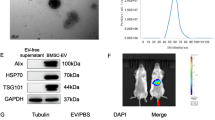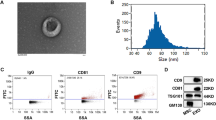Abstract
Liver fibrosis is a hallmark feature of many chronic liver diseases, which is the leading cause of morbidity and mortality worldwide. Bone marrow mesenchymal stem cells (BMSCs)-derived extracellular vesicles have been applied in many diseases. In this study, we aimed to explore the specific mechanism of extracellular vesicles from BMSCs in liver fibrosis. Bioinformatics analysis was employed to screen miRNA and its target mRNA. Sirius Red staining was carried out to examine fibrosis in liver tissues. Extracellular vesicle morphology was assessed using Transmission Electron Microscopy. Quantitative real-time PCR (qRT-PCR) and western blotting analysis were performed to detect the expressions of miR-148a-5p, Smad4, transforming growth factor-β1 (TGF-β1), tissue inhibitor of metalloproteinase 1 (TIMP-1), Collagen I, α-smooth muscle actin (α-SMA), and extracellular vesicle markers CD9, TSG101, CD63, and calnexin. Dual-luciferase report gene assay was used for the luciferase activity analysis. Bioinformatics analysis revealed miR-148a-5p as a regulator in liver fibrosis. QRT-PCR results indicated that miR-148a-5p was lowly expressed in both thioacetamide (TAA)-induced mice and TGF-β1-activated hepatic stellate cells. Extracellular vesicles from miR-148a-5p enriched BMSCs downregulated the mRNA and protein levels of TGF-β1, TIMP-1, Collagen I, and α-SMA. Further bioinformatics analysis indicated that Smad4 was related to liver fibrosis. Furthermore, the dual-luciferase report gene assay confirmed the binding relationship between miR-148a-5p and Smad4. Extracellular vesicles from miR-148a-5p enriched BMSCs attenuated hepatic fibrosis in liver fibrosis by targeting Smad4.





Similar content being viewed by others
References
Bataller, R., & Brenner, D. A. (2005). Liver fibrosis. The Journal of Clinical Investigation, 115(2), 209–218.
Hernandez-Gea, V., & Friedman, S. L. (2011). Pathogenesis of liver fibrosis. Annual Review of Pathology: Mechanisms of Disease, 6, 425–456.
Udomsinprasert, W., & Jittikoon, J. (2019). Vitamin D and liver fibrosis: Molecular mechanisms and clinical studies. Biomedicine & Pharmacotherapy, 109, 1351–1360.
Lu, W., Li, X., Liu, N., Zhang, Y., Li, Y., Pan, Y., Yang, J., Liu, Z., & Kong, J. (2021). Vitamin D alleviates liver fibrosis by inhibiting histidine-rich calcium binding protein (HRC). Chemico-Biological Interactions, 334, 109355.
Wang, H. W., Lai, H. C., Hu, T. H., Su, W. P., Lu, S. N., Lin, C. H., Hung, C. H., Chuang, P. H., Wang, J. H., Lee, M. H., et al. (2020). On-treatment changes in FIB-4 and 1-Year FIB-4 values help identify patients with chronic hepatitis B receiving entecavir therapy who have the lowest risk of hepatocellular carcinoma. Cancers (Basel), 12(5), 1177.
Tachi, Y., Hirai, T., Ishizu, Y., Honda, T., Kuzuya, T., Hayashi, K., Ishigami, M., & Goto, H. (2016). α-fetoprotein levels after interferon therapy predict regression of liver fibrosis in patients with sustained virological response. Journal of Gastroenterology and Hepatology, 31(5), 1001–1008.
Schuppan, D. (2015). Liver fibrosis: Common mechanisms and antifibrotic therapies. Clinics and Research in Hepatology and Gastroenterology, 39(Suppl 1), S51-59.
Koyama, Y., Xu, J., Liu, X., & Brenner, D. A. (2016). New developments on the treatment of liver fibrosis. Digestive Diseases, 34(5), 589–596.
Wu, J., Ji, C., Cao, F., Lui, H., Xia, B., & Wang, L. (2017). Bone marrow mesenchymal stem cells inhibit dendritic cells differentiation and maturation by microRNA-23b. Bioscience Reports, 37(2), BSR20160436.
Wang, L., Niu, N., Li, L., Shao, R., Ouyang, H., & Zou, W. (2018). H3K36 trimethylation mediated by SETD2 regulates the fate of bone marrow mesenchymal stem cells. PLoS Biology, 16(11), e2006522.
Xu, T. B., Li, L., Luo, X. D., & Lin, H. (2017). BMSCs protect against liver injury via suppressing hepatocyte apoptosis and activating TGF-β1/Bax singling pathway. Biomedicine & Pharmacotherapy = Biomedecine & Pharmacotherapie, 96, 1395–1402.
Xiu, G., Li, X., Yin, Y., Li, J., Li, B., Chen, X., Liu, P., Sun, J., & Ling, B. (2020). SDF-1/CXCR4 augments the therapeutic effect of bone marrow mesenchymal stem cells in the treatment of lipopolysaccharide-induced liver injury by promoting their migration through PI3K/Akt signaling pathway. Cell Transplantation, 29, 963689720929992.
Khadrawy, S. M., Mohamed, H. M., & Mahmoud, A. M. (2021). Mesenchymal stem cells ameliorate oxidative stress, inflammation, and hepatic fibrosis via Nrf2/HO-1 signaling pathway in rats. Environmental Science and Pollution Research International, 28(2), 2019–2030.
Liu, T., Zhang, Q., Zhang, J., Li, C., Miao, Y. R., Lei, Q., Li, Q., & Guo, A. Y. (2019). EVmiRNA: A database of miRNA profiling in extracellular vesicles. Nucleic Acids Research, 47(D1), D89-d93.
Ding, F., Liu, J., & Zhang, X. (2020). microRNA-375 released from extracellular vesicles of bone marrow mesenchymal stem cells exerts anti-oncogenic effects against cervical cancer. Stem Cell Research & Therapy, 11(1), 455.
Huang, S., & Li, Y. (2020). microRNA-148a-3p in extracellular vesicles derived from bone marrow mesenchymal stem cells suppresses SMURF1 to prevent osteonecrosis of femoral head. Journal of Cellular and Molecular Medicine, 24(19), 11512–11523.
Chen, C. Y., Chao, Y. M., Lin, H. F., Chen, C. J., Chen, C. S., Yang, J. L., Chan, J. Y. H., & Juo, S. H. (2020). miR-195 reduces age-related blood-brain barrier leakage caused by thrombospondin-1-mediated selective autophagy. Aging Cell, 19(11), e13236.
Valadi, H., Ekström, K., Bossios, A., Sjöstrand, M., Lee, J. J., & Lötvall, J. O. (2007). Exosome-mediated transfer of mRNAs and microRNAs is a novel mechanism of genetic exchange between cells. Nature Cell Biology, 9(6), 654–659.
Zhang, Z., Tang, H., Wang, Z., Zhang, B., Liu, W., Lu, H., Xiao, L., Liu, X., Wang, R., Li, X., et al. (2011). MiR-185 targets the DNA methyltransferases 1 and regulates global DNA methylation in human glioma. Molecular Cancer, 10, 124.
Tominaga, N., Kosaka, N., Ono, M., Katsuda, T., Yoshioka, Y., Tamura, K., Lötvall, J., Nakagama, H., & Ochiya, T. (2015). Brain metastatic cancer cells release microRNA-181c-containing extracellular vesicles capable of destructing blood-brain barrier. Nature Communications, 6, 6716.
Zhang, K., Dong, C., Chen, M., Yang, T., Wang, X., Gao, Y., Wang, L., Wen, Y., Chen, G., Wang, X., et al. (2020). Extracellular vesicle-mediated delivery of miR-101 inhibits lung metastasis in osteosarcoma. Theranostics, 10(1), 411–425.
Zheng, L., Zhu, K., Jiao, H., Zhao, Z., Zhang, L., Liu, M., Deng, W., Chen, D., Yao, Z., & Xiao, G. (2013). PTHrP expression in human MDA-MB-231 breast cancer cells is critical for tumor growth and survival and osteoblast inhibition. International Journal of Biological Sciences, 9(8), 830–841.
Mu, M., Zuo, S., Wu, R. M., Deng, K. S., Lu, S., Zhu, J. J., Zou, G. L., Yang, J., Cheng, M. L., & Zhao, X. K. (2018). Ferulic acid attenuates liver fibrosis and hepatic stellate cell activation via inhibition of TGF-β/Smad signaling pathway. Drug Design, Development and Therapy, 12, 4107–4115.
Munir, J., Yoon, J. K., & Ryu, S. (2020). Therapeutic miRNA-enriched extracellular vesicles: Current approaches and future prospects. Cells, 9(10), 2271.
Wei, H., Wang, J., Xu, Z., Li, W., Wu, X., Zhuo, C., Lu, Y., Long, X., Tang, Q., & Pu, J. (2021). Hepatoma cell-derived extracellular vesicles promote liver cancer metastasis by inducing the differentiation of bone marrow stem cells through microRNA-181d-5p and the FAK/Src pathway. Frontiers in cell and developmental biology, 9, 607001.
Deng, L., Wang, C., He, C., & Chen, L. (2021). Bone mesenchymal stem cells derived extracellular vesicles promote TRAIL-related apoptosis of hepatocellular carcinoma cells via the delivery of microRNA-20a-3p. Cancer Biomarkers: Section A of Disease Markers, 30(2), 223–235.
Xu, Y., Sun, X., Zhang, R., Cao, T., Cai, S. Y., Boyer, J. L., Zhang, X., Li, D., & Huang, Y. (2020). A positive feedback loop of TET3 and TGF-β1 promotes liver fibrosis. Cell Reports, 30(5), 1310-1318.e1315.
Schwartz, B. E., Rajagopal, V., Smith, C., Cohick, E., Whissell, G., Gamboa, M., Pai, R., Sigova, A., Grossman, I., Bumcrot, D., et al. (2020). Discovery and targeting of the signaling controls of PNPLA3 to effectively reduce transcription, expression, and function in pre-clinical NAFLD/NASH settings. Cells, 9(10), 2247.
Xiang, H., Han, Y., Zhang, Y., Yan, W., Xu, B., Chu, F., Xie, T., Jia, M., Yan, M., Zhao, R., et al. (2017). A new oleanolic acid derivative against CCl4-induced hepatic fibrosis in rats. International Journal of Molecular Sciences, 18(3), 553.
Liu, X., Huang, K., Zhang, R. J., Mei, D., & Zhang, B. (2020). Isochlorogenic acid A attenuates the progression of liver fibrosis through regulating HMGB1/TLR4/NF-κB signaling pathway. Frontiers in Pharmacology, 11, 582.
Trivedi, P., Wang, S., & Friedman, S. L. (2021). The power of plasticity-metabolic regulation of hepatic stellate cells. Cell Metabolism, 33(2), 242–257.
Shi, W. P., Ju, D., Li, H., Yuan, L., Cui, J., Luo, D., Chen, Z. N., & Bian, H. (2018). CD147 promotes CXCL1 expression and modulates liver fibrogenesis. International Journal of Molecular Sciences, 19(4), 1145.
Higashi, T., Friedman, S. L., & Hoshida, Y. (2017). Hepatic stellate cells as key target in liver fibrosis. Advanced Drug Delivery Reviews, 121, 27–42.
Klepfish, M., Gross, T., Vugman, M., Afratis, N. A., Havusha-Laufer, S., Brazowski, E., Solomonov, I., Varol, C., & Sagi, I. (2020). LOXL2 inhibition paves the way for macrophage-mediated collagen degradation in liver fibrosis. Frontiers in Immunology, 11, 480.
Zhang, J., Zhang, Y., Shen, W., Fu, R., Ding, Z., Zhen, Y., & Wan, Y. (2019). Cytological effects of honokiol treatment and its potential mechanism of action in non-small cell lung cancer. Biomedicine & Pharmacotherapy, 117, 109058.
Han, H., Sun, D., Li, W., Shen, H., Zhu, Y., Li, C., Chen, Y., Lu, L., Li, W., Zhang, J., et al. (2013). A c-Myc-MicroRNA functional feedback loop affects hepatocarcinogenesis. Hepatology, 57(6), 2378–2389.
Shu, C., Yan, D., Chen, C., Mo, Y., Wu, L., Gu, J., Shah, N. K., He, J., & Dong, S. (2019). Metformin exhibits its therapeutic effect in the treatment of pre-eclampsia via modulating the Met/H19/miR-148a-5p/P28 and Met/H19/miR-216–3p/EBI3 signaling pathways. International Immunopharmacology, 74, 105693.
Ishida, K., & Jolly, E. R. (2016). Hsp70 may be a molecular regulator of schistosome host invasion. PLoS Neglected Tropical Diseases, 10(9), e0004986.
Wang, Y., Huang, H. Y., Bian, G. L., Yu, Y. S., Ye, W. X., Hua, F., Chen, Y. H., & Shen, Z. Y. (2017). A functional variant of SMAD4 enhances thoracic aortic aneurysm and dissection risk through promoting smooth muscle cell apoptosis and proteoglycan degradation. eBioMedicine, 21, 197–205.
Cheng, Q., Li, C., Yang, C. F., Zhong, Y. J., Wu, D., Shi, L., Chen, L., Li, Y. W., & Li, L. (2019). Methyl ferulic acid attenuates liver fibrosis and hepatic stellate cell activation through the TGF-β1/Smad and NOX4/ROS pathways. Chemico-Biological Interactions, 299, 131–139.
Liu, J., Kong, D., Qiu, J., Xie, Y., Lu, Z., Zhou, C., Liu, X., Zhang, R., & Wang, Y. (2019). Praziquantel ameliorates CCl(4) -induced liver fibrosis in mice by inhibiting TGF-β/Smad signalling via up-regulating Smad7 in hepatic stellate cells. British Journal of Pharmacology, 176(24), 4666–4680.
Zou, Y., Li, S., Li, Z., Song, D., Zhang, S., & Yao, Q. (2019). MiR-146a attenuates liver fibrosis by inhibiting transforming growth factor-β1 mediated epithelial-mesenchymal transition in hepatocytes. Cellular Signalling, 58, 1–8.
Funding
This work was supported by the ‘333 High-level Talents Project’ of Jiangsu Province (Grant No. BRA2018408), the Medical Scientific Research Project of Jiangsu Provincial Health Commission (Grant No. H2019073), and the Natural Science Foundation of Jiangsu Province (Youth Project, SBK2020041194).
Author information
Authors and Affiliations
Corresponding author
Ethics declarations
Conflict of interest
The authors declare that they have no conflict of interest.
Additional information
Publisher's Note
Springer Nature remains neutral with regard to jurisdictional claims in published maps and institutional affiliations.
Supplementary Information
Below is the link to the electronic supplementary material.
12033_2021_441_MOESM1_ESM.jpg
Supplementary Figure 1 Culture and identification of primary BMSCs. (A) Morphological observation of primary BMSCs (scale bar: 100 μm). (B) The positive rates of CD105, CD73, and CD45 were analyzed by flow cytometry. (JPG 3551 kb)
Rights and permissions
About this article
Cite this article
Xuan, J., Xu, H., Li, H. et al. Extracellular Vesicles from miR-148a-5p-Enriched Bone Marrow Mesenchymal Stem Cells Relieve Hepatic Fibrosis by Targeting Smad4. Mol Biotechnol 64, 535–545 (2022). https://doi.org/10.1007/s12033-021-00441-5
Received:
Accepted:
Published:
Issue Date:
DOI: https://doi.org/10.1007/s12033-021-00441-5




